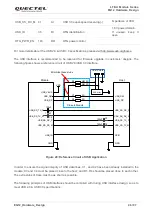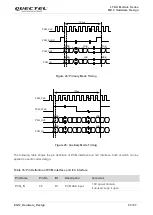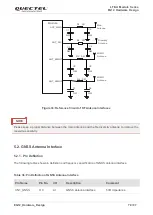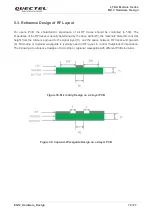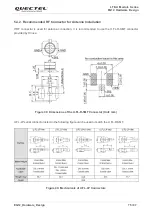
LTE-A Module Series
EG12 Hardware Design
EG12_Hardware_Design 60 / 97
3.18.2. Endpoint Mode
In this mode, the module is configured to act as a PCIe EP device. The following figure shows a reference
circuit of PCIe EP mode.
GND
PCIE_TX_M
PCIE_TX_P
GND
PCIE_RX_M
PCIE_RX_P
PCIE_RX_M
PCIE_RX_P
PCIE_TX_M
PCIE_TX_P
C3
C4
USB_DP
USB_DM
R1
R2
0R
0R
USB_DM
USB_DP
C1
C2
ESD Array
100nF
100nF
100nF
100nF
Module
Host
R3
R4
NM_0R
NM_0R
Test Points
Minimize these stubs
PCIE_REFCLK_P
PCIE_REFCLK_M
PCIE_REFCLK_P
PCIE_REFCLK_M
PCIE_RST_N
PCIE_CLKREQ_N
PCIE_WAKE_N
PCIE_RST_N
PCIE_CLKREQ_N
PCIE_WAKE_N
Figure 30: PCIe Interface Reference Circuit (EP Mode)
In order to ensure the signal integrity of PCIe interface, C1 and C2 have been placed inside the module.
C3 and C4 should be placed close to the MCU, and R1, R2, R3 and R4 should be placed close to the
module and also close to each other. The extra stubs of trace must be as short as possible.
The following principles of PCIe interface design should be complied with, so as to meet PCIe V2.1
specifications.
It is important to route the USB 2.0 & PCIe signal traces as differential pairs with total grounding.
For USB 2.0 signal traces,
the trace lengths should be less than 120mm, the differential data pair
matching should be less than 2mm (15ps).
For PCIe signal traces, the maximum length of each differential data pair (TX/RX) is recommended to
be less than 250mm, and each differential data pair matching should be less than 0.7mm (5ps).
Do not route signal traces under crystals, oscillators, magnetic devices or RF signal traces. It is
important to route the PCIe differential traces in inner-layer of the PCB, and surround the traces with
ground on that layer and with ground planes above and below.
If possible, reserve a 0
Ω resistor on USB_DP and USB_DM lines, respectively.

